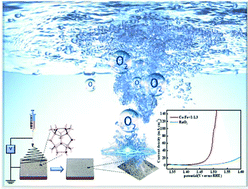Amorphous cobalt–iron hydroxides as high-efficiency oxygen-evolution catalysts based on a facile electrospinning process†
Abstract
Amorphous hydroxide on a foamed nickel substrate was fabricated by a simple and efficient electrospinning method for the first time. In untreated alkaline medium, amorphous cobalt (Co)–iron (Fe) hydroxide showed oxygen-evolution advantages over the typical reference catalyst (RuO2). When tested with a three-electrode system in 1 M KOH, the obtained amorphous PVP/CoFe1.3 nanofibers possessed remarkable catalytic activity and stability for the oxygen evolution reaction (OER) with a low overpotential of 0.267 V at 100 mA cm−2 and a low Tafel slope of 47.43 mV dec−1. The amorphous CoFe microfibers were synthesized by electrospinning, and stable CoFe hydroxides can be further formed in the alkaline environment. The synergistic effect between two different amorphous CoFe-based hydroxides contributed to excellent electrocatalytic activity. Therefore, the design of amorphous CoFe hydroxide enabled the development of a high-efficiency OER catalyst and opens possibilities for the large-scale and environmentally friendly production of water splitting.



 Please wait while we load your content...
Please wait while we load your content...